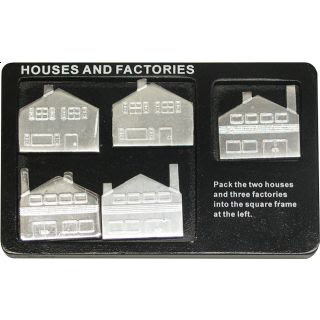
It has a great weight to it and I really like the appearance. The contrast between the gold and silver is nice; I like it when they use a shiny finish like this.
The motion of the puzzle is also quite nice: the pieces slide apart in an interesting 4-piece coordinate motion. However, they stop short of coming completely apart, so the puzzle is to get them apart and back together.
I tried a number of things, but couldn't get beyond just sliding the pieces apart and together. After about 5-10 minutes, I discovered something that helped me figure out how to get it apart.
Unfortunately, it turned out that this puzzle was vulnerable to my "shake-the-hell-out-of-it" approach. I don't really consider that a spoiler, because that is not the correct solution. So if you want to get the maximum difficulty of this puzzle, don't just try to pull it apart while shaking it. After inspecting the pieces, I was able to see what the correct solution was, so I'm not sure how much longer it would take to figure it out the proper way to do it.
Interestingly, depending on how you reassemble it, the solution is different, which is quite an interesting feature. However, once you have disassembled it once and seen how it works, finding the additional solutions is only moderately challenging.
Overall, a decent puzzle, but you can solve it by doing one of the first things frustrated people do: just shake it around randomly until it comes apart. It would be much more interesting if it was designed in a way that makes this not work, which would also make it much more difficult.
As I mentioned in a previous post, I found a series of bamboo puzzles produced under the name "EcoGame" at Urban Outfitters. In the comments, Roland Koch noted that in the photo I posted of the full lineup, the Soma cube looked quite similar to his 2002 IPP Design Competition entry, Soma Summarum, but with a slightly different objective.
In the bamboo version, this was obviously impossible, but Roland thought that perhaps the objective had been changed to make the layers appear all the way around the puzzle.
 I was curious if this was indeed the case, so decided to pick this puzzle up while I was at Eureka as well.
I was curious if this was indeed the case, so decided to pick this puzzle up while I was at Eureka as well.
As soon as I got it out of the packaging and looked at the pieces, I thought it was pretty clear that this objective would not be possible. I fiddled with it for a few minutes to confirm my suspicion, and tried it out in BurrTools just to be safe. Oh well!
It looks like the striped pattern is more just for esthetics than as part of the puzzle. Here is the full set of pieces:
Still, it is actually a fairly nice Soma cube: the finish is pretty good, the striped pattern is interesting, and the pieces fit together very well. I'll probably find one of the many websites that has shapes that you can make from these pieces and have a grand ol' puzzling time with them.



























